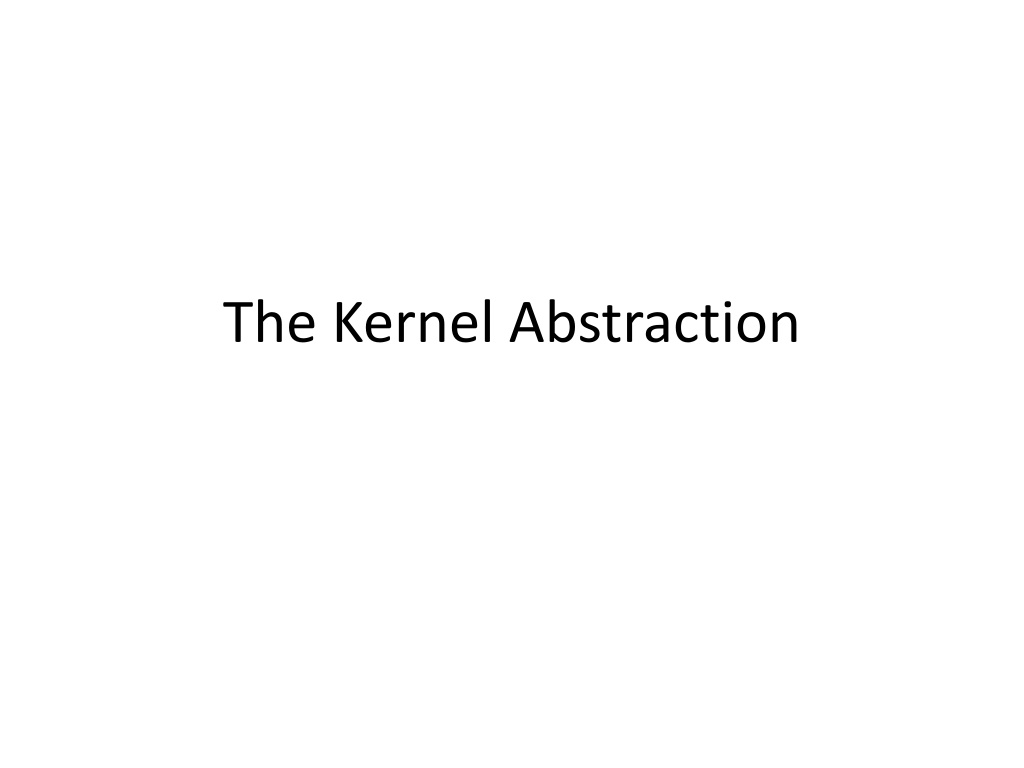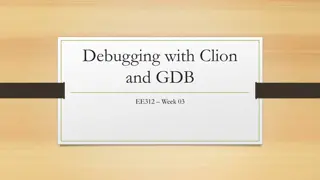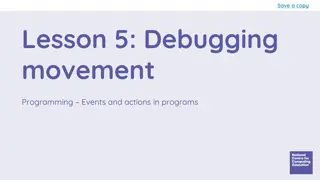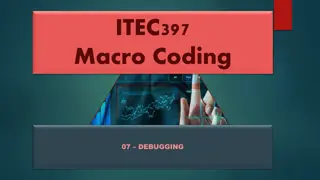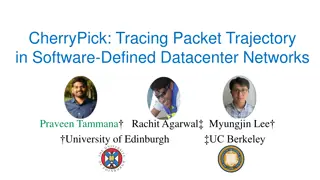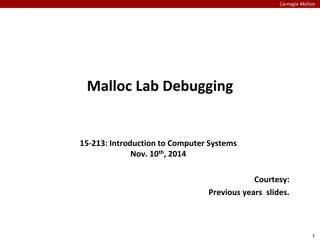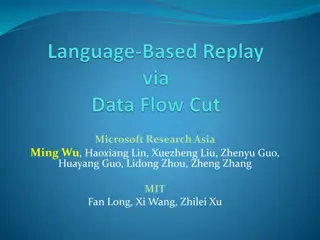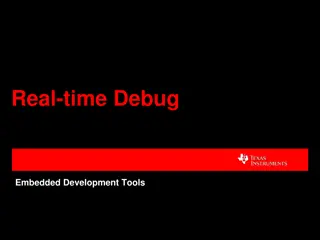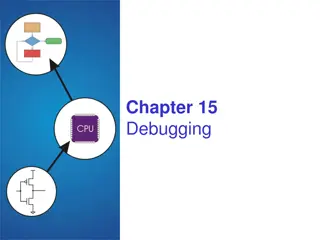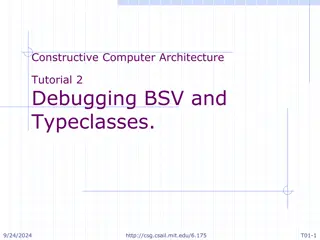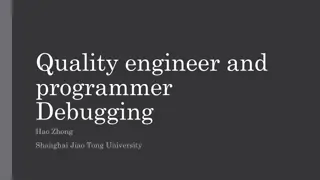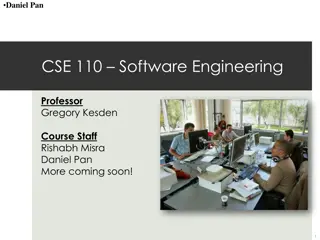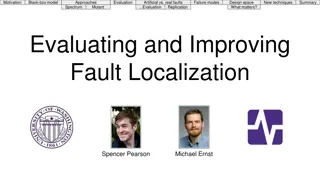Strategies to Reduce Time Spent Debugging in Software Development
Strategies for reducing debugging time in software development include producing working code with minimal effort, optimizing processes involving code and computer, forming hypotheses to explain bugs, conducting tests, using best practices, and conducting experiments for effective debugging. Significant focus on debugging is essential, as it constitutes a substantial portion of software development time, especially in kernel development.
Download Presentation

Please find below an Image/Link to download the presentation.
The content on the website is provided AS IS for your information and personal use only. It may not be sold, licensed, or shared on other websites without obtaining consent from the author. Download presentation by click this link. If you encounter any issues during the download, it is possible that the publisher has removed the file from their server.
E N D
Presentation Transcript
Debugging as Engineering Much of your time in this course will be spent debugging In industry, 50% of software dev is debugging Even more for kernel development How do you reduce time spent debugging? Produce working code with smallest effort Optimize a process involving you, code, computer
Debugging as Science Understanding -> design -> code not the opposite Form a hypothesis that explains the bug Which tests work, which don t. Why? Add tests to narrow possible outcomes Use best practices Always walk through your code line by line Module tests narrow scope of where problem is Develop code in stages, with dummy replacements for later functionality
ABET You can t debug effectively without this: b. Ability to design and conduct experiments, analyze and interpret data.
Device Interrupts OS kernel needs to communicate with physical devices Devices operate asynchronously from the CPU Polling: Kernel waits until I/O is done Interrupts: Kernel can do other work in the meantime Device access to memory Programmed I/O: CPU reads and writes to device Direct memory access (DMA) by device Buffer descriptor: sequence of DMA s E.g., packet header and packet body Queue of buffer descriptors Buffer descriptor itself is DMA ed
Device Interrupts How do device interrupts work? Where does the CPU run after an interrupt? What is the interrupt handler written in? C? Java? What stack does it use? Is the work the CPU had been doing before the interrupt lost forever? If not, how does the CPU know how to resume that work?
Challenge: Protection How do we execute code with restricted privileges? Either because the code is buggy or if it might be malicious Some examples: A script running in a web browser A program you just downloaded off the Internet A program you just wrote that you haven t tested yet
Main Points Process concept A process is the OS abstraction for executing a program with limited privileges Dual-mode operation: user vs. kernel Kernel-mode: execute with complete privileges User-mode: execute with fewer privileges Safe control transfer How do we switch from one mode to the other?
Process Abstraction Process: an instance of a program, running with limited rights Thread: a sequence of instructions within a process Potentially many threads per process (for now 1:1) Address space: set of rights of a process Memory that the process can access Other permissions the process has (e.g., which system calls it can make, what files it can access)
Thought Experiment How can we implement execution with limited privilege? Execute each program instruction in a simulator If the instruction is permitted, do the instruction Otherwise, stop the process Basic model in Javascript and other interpreted languages How do we go faster? Run the unprivileged code directly on the CPU!
Hardware Support: Dual-Mode Operation Kernel mode Execution with the full privileges of the hardware Read/write to any memory, access any I/O device, read/write any disk sector, send/read any packet User mode Limited privileges Only those granted by the operating system kernel On the x86, mode stored in EFLAGS register On the MIPS, mode in the status register
Hardware Support: Dual-Mode Operation Privileged instructions Available to kernel Not available to user code Limits on memory accesses To prevent user code from overwriting the kernel Timer To regain control from a user program in a loop Safe way to switch from user mode to kernel mode, and vice versa
Privileged instructions Examples? What should happen if a user program attempts to execute a privileged instruction?
Question For a Hello world program, the kernel must copy the string from the user program memory into the screen memory. Why not allow the application to write directly to the screen s buffer memory?
Towards Virtual Addresses Problems with base and bounds?
Virtual Addresses Translation done in hardware, using a table Table set up by operating system kernel
Example int staticVar = 0; // a static variable main() { staticVar += 1; sleep(10); // sleep for x seconds printf ("static address: %x, value: %d\n", &staticVar, staticVar); } What happens if we run two instances of this program at the same time? What if we took the address of a procedure local variable in two copies of the same program running at the same time?
Question With an object-oriented language and compiler, only an object s methods can access the internal data inside an object. If the operating system only ran programs written in that language, would it still need hardware memory address protection? What if the contents of every object were encrypted except when its method was running, including the OS?
Hardware Timer Hardware device that periodically interrupts the processor Returns control to the kernel handler Interrupt frequency set by the kernel Not by user code! Interrupts can be temporarily deferred Not by user code! Interrupt deferral crucial for implementing mutual exclusion
Mode Switch From user mode to kernel mode Interrupts Triggered by timer and I/O devices Exceptions Triggered by unexpected program behavior Or malicious behavior! System calls (aka protected procedure call) Request by program for kernel to do some operation on its behalf Only limited # of very carefully coded entry points
Question Examples of exceptions Examples of system calls
Mode Switch From kernel mode to user mode New process/new thread start Jump to first instruction in program/thread Return from interrupt, exception, system call Resume suspended execution Process/thread context switch Resume some other process User-level upcall (UNIX signal) Asynchronous notification to user program
How do we take interrupts safely? Interrupt vector Limited number of entry points into kernel Atomic transfer of control Single instruction to change: Program counter Stack pointer Memory protection Kernel/user mode Transparent restartable execution User program does not know interrupt occurred
Interrupt Vector Table set up by OS kernel; pointers to code to run on different events
Interrupt Stack Per-processor, located in kernel (not user) memory Usually a process/thread has both: kernel and user stack Why can t the interrupt handler run on the stack of the interrupted user process?
Interrupt Masking Interrupt handler runs with interrupts off Re-enabled when interrupt completes OS kernel can also turn interrupts off Eg., when determining the next process/thread to run On x86 CLI: disable interrrupts STI: enable interrupts Only applies to the current CPU (on a multicore) We ll need this to implement synchronization in chapter 5
Interrupt Handlers Non-blocking, run to completion Minimum necessary to allow device to take next interrupt Any waiting must be limited duration Wake up other threads to do any real work Linux: semaphore Rest of device driver runs as a kernel thread
Case Study: MIPS Interrupt/Trap Two entry points: TLB miss handler, everything else Save type: syscall, exception, interrupt And which type of interrupt/exception Save program counter: where to resume Save old mode, interruptable bits to status register Set mode bit to kernel Set interrupts disabled For memory faults Save virtual address and virtual page Jump to general exception handler
Case Study: x86 Interrupt Save current stack pointer Save current program counter Save current processor status word (condition codes) Switch to kernel stack; put SP, PC, PSW on stack Switch to kernel mode Vector through interrupt table Interrupt handler saves registers it might clobber
Question Why is the stack pointer saved twice on the interrupt stack? Hint: is it the same stack pointer?
At end of handler Handler restores saved registers Atomically return to interrupted process/thread Restore program counter Restore program stack Restore processor status word/condition codes Switch to user mode
Upcall: User-level event delivery Notify user process of some event that needs to be handled right away Time expiration Real-time user interface Time-slice for user-level thread manager Interrupt delivery for VM player Asynchronous I/O completion (async/await) AKA UNIX signal
Upcalls vs Interrupts Signal handlers = interrupt vector Signal stack = interrupt stack Automatic save/restore registers = transparent resume Signal masking: signals disabled while in signal handler
Kernel System Call Handler Locate arguments In registers or on user stack Translate user addresses into kernel addresses Copy arguments From user memory into kernel memory Protect kernel from malicious code evading checks Validate arguments Protect kernel from errors in user code Copy results back into user memory Translate kernel addresses into user addresses
User-Level Virtual Machine How does VM Player work? Runs as a user-level application How does it catch privileged instructions, interrupts, device I/O? Installs kernel driver, transparent to host kernel Requires administrator privileges! Modifies interrupt table to redirect to kernel VM code If interrupt is for VM, upcall If interrupt is for another process, reinstalls interrupt table and resumes kernel
